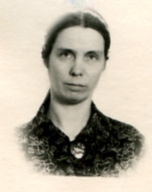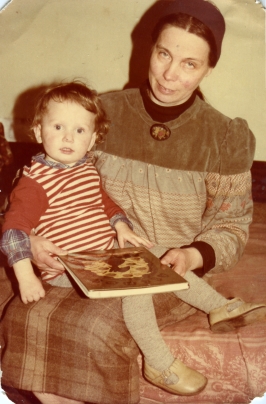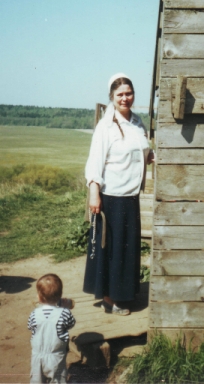Lida Goncharova — The First Gold IMO Girl
 Janet Mertz wrote several papers about the gender gap in mathematics. One of her research ideas was to find girls who went to the International Math Olympiad (IMO) and compare their fate to that of their teammates with a similar score. She asked me to find Soviet and Russian IMO girls. All my life I had heard about Lida Goncharova, the first girl on a Soviet team, and the first girl in the world who took a gold medal, but I had never dared to reach out to her. A little push by Janet Mertz was enough for me to find Lida’s phone number in Moscow and call her.
Janet Mertz wrote several papers about the gender gap in mathematics. One of her research ideas was to find girls who went to the International Math Olympiad (IMO) and compare their fate to that of their teammates with a similar score. She asked me to find Soviet and Russian IMO girls. All my life I had heard about Lida Goncharova, the first girl on a Soviet team, and the first girl in the world who took a gold medal, but I had never dared to reach out to her. A little push by Janet Mertz was enough for me to find Lida’s phone number in Moscow and call her.
My conversation with Lida Goncharova

Lida got interested in mathematics when she was five years old. Luckily, many of her relatives were mathematicians and she started bugging them for math puzzles.
Her involvement with math was interrupted by the death of her parents — her mother when she was seven, and her father when she was nine. She ended up living with her sister, but felt very lonely.
After several years of personal turmoil, she renewed her pursuit of mathematics. Lida started discussing math with her mother’s first husband. She joined a math circle which was run at Moscow State University. When she was 13 she went to a summer camp and found a mentor there to study trigonometry. Eventually she ended up at School Number 425, one of the first schools in Moscow that opened for children gifted in math.
At the end of high school she went to the IMO as part of the Soviet team and won a gold medal there. After that she enrolled in the most prestigious Soviet institute for the study of math — Moscow State University (MSU).
Half of her high school classmates went to MSU, including her high school sweetheart Alexander Geronimus. Lida married Alexander when she was a sophomore and they had their first son in her fourth year of undergraduate school.
Meanwhile, she wasn’t doing as well in her studies as she had hoped. Lida was very fast to pick up math ideas during conversations, but she had difficulty reading books. As ideas were becoming more complicated and involved, this became a problem. She started feeling that she was falling behind her friends. When her friends gathered together to discuss mathematics she couldn’t understand everything. She wanted to ask questions, but was too shy. Plus, she didn’t want to impose on them. She made a decision to be silent. As a result she started ignoring the conversations of others and became discouraged as she fell behind.
She had her second child at the beginning of graduate school, where she studied under the supervision of Dmitry Fuchs. Lida was already losing her self-esteem and so she chose a self-contained problem that didn’t require a lot of outside knowledge. The solution involved some combinatorial methods, but Lida didn’t quite understand the big picture and the problem’s goal.
I contacted Dmitry Fuchs and asked him about Lida’s thesis. He told me that Lida’s main result is extremely important and widely cited. It is called Goncharova’s theorem.
Meanwhile, her husband finished his PhD in math and secured a great job in an academic institution. They had started as peers, but her work was interrupted by having their children. Lida finished her PhD a couple of years after her husband and got a very boring job as an algorithm designer. She even wrote some papers at the job, but she was not much interested. She continued her attempts to do mathematics and continued asking everyone for problems, but it didn’t go anywhere. Her friends were not very interested in her calculations and after the birth of her third child she began to lose hope in her research.
When Lida and her husband entered graduate school they became religious. Ten years later, Alexander decided to pursue the Russian Orthodox religion as a career and got a parish in 600 km from Moscow. They didn’t want to move their children away from Moscow, with its educational and cultural opportunities. So they started living in two places with long commutes. This didn’t help her math either.
Eight years after the third son, the fourth son was born. Although Lida sporadically continued her calculations, she still didn’t talk about them to anyone.
When the older children went to high school, Lida enjoyed solving their math problems tremendously. In 1990 perestroika started and Lida lost her job. She got an offer to create a private school and teach there. By this time she had had two more children, a son and a daughter. Lida continued working for the private school until her six children grew out of it. Lida enjoyed teaching and inventing methods to teach mathematics. The school ended in 2004. But she continues working with kids sharing with them her joy of mathematics.
Lida believes that she has had an extremely lucky life in many ways. The only exception was her unsuccessful math career. She can’t live without math, and will continue working with kids, solving fun problems and doing her private research.
When I first called her and said I wanted to talk about her and math, she told me: —There is nothing to talk about. I stopped doing math after my PhD. Almost.— That —almost— kept me asking questions.
Lida’s teammates

Janet Mertz was considering a serious research project comparing the fates of IMO medal girls with the fates of their teammates, to see whether gender plays a role later. However, due to the language and cultural differences and the fact that most of the girls changed their last name, it was difficult to locate them. So Mertz put this research project on hold.
She had asked me to find and contact the Russian women and I was so fascinated with Lida’s story that I decided to write it up in this article. And because the research is on hold, I decided to include the fates of Lida’s teammates.
Lida Goncharova got her gold medal in the 1962 IMO with 42 points and was ranked third. The teammate with the closest score was Joseph Bernstein with another gold medal and 46 points. I don’t even have to check Wikipedia to tell you about Joseph, as I was once married to him. He used to be a professor at Harvard University and is now a professor at Tel-Aviv University. He is a member of the Israel Academy of Sciences and Humanities and the United States National Academy of Sciences. He achieved a lot and is greatly respected by his peers.
Joseph Bernstein might not be the best person to compare Lida to as he had a perfect score. Some might argue that a perfect score indicates that he might have done better if the problems had been more difficult.
The two Soviet teammates whose scores were the closest to that of Lida, but below her, were Alexey Potepun with 37 points and Grigory Margulis with 36 points.
Alexei Potepun got a PhD in mathematics and is now a professor at Saint-Petersburg University. He has published eleven papers.
Next to Alexey Potepun is Grigory Margulis, who is a professor at Yale and was awarded the Fields Medal and the Wolf Prize. He is a member of the U.S. National Academy of Sciences.
You might notice that the two people who moved to the US are much more famous than those who stayed in Russia. You might say that moving to the US is a better predictor of success than gender. Sure, living in a free country helps, but Margulis got his Fields medal while he was in the USSR. And Bernstein invented his famous D-Modules while in Russia also.
My conversation with Lida was personally inspiring. I loved the tone of her voice when she talked about mathematics. There were many elements that prevented her from having the mathematical career she might have had: the untimely death of her parents, her shyness, raising six children, many years of long commutes. When we look at the achievements of her closest teammates, we can’t help but wonder what kind of mathematics we lost.
This conversation was very encouraging for me. I felt there were similarities between Lida and myself in more ways than I expected. What we share most of all is a love for mathematics. I could hear that in her voice.
Share:
Tanya Khovanova:
Wiki article about Alexander Geronimus (in Russian): https://ru.wikipedia.org/wiki/%D0%93%D0%B5%D1%80%D0%BE%D0%BD%D0%B8%D0%BC%D1%83%D1%81,_%D0%90%D0%BB%D0%B5%D0%BA%D1%81%D0%B0%D0%BD%D0%B4%D1%80_%D0%AE%D1%80%D1%8C%D0%B5%D0%B2%D0%B8%D1%87
24 December 2010, 10:10 amFelipe Pait:
Very interesting article! Thanks for writing it.
I think you can’t really say how things happen with one person who has talent, but for talent to develop many conditions must be present. Statistically, each of the negative factors that you cited can become an extra obstacle. (Yes, I haven’t said much here.)
24 December 2010, 10:30 amTanya Khovanova:
A modern picture of Lida Goncharova:
27 December 2010, 2:04 pmhttps://www.sfi.ru/rubrs.asp?rubr_id=186&art_id=12413
(the article is in Russian)
Maria Roginskaya:
I think what the story shows is that while MGU might was most prestigeous school in USSR it was not most efficient (when it comes to Mathematics). St.Petersburg University was more efficient (and I don’t think I’m biased by attending it myself :-)). By efficiency I don’t mean that the knowledge provided were any worse, but that the way to teach in MGU was adjusted to only one type of personality (self-sure and driven?).
1 January 2011, 11:08 amHillary:
This article is just fascinating to me for several reasons. It must have been a really amazing thing to be able to learn about Lida’s personal life by talking to her directly!
10 January 2011, 1:14 pmTanya Khovanova’s Math Blog » Blog Archive » The Second IMO Gold Girl:
[…] who in 1962 was the first girl to win an IMO gold medal. So I located her, and after an interview, wrote about her. Only 14 years later, in 1976, did the next girl get a gold medal. That was me. I was ranked […]
4 February 2011, 2:02 pmGordana:
I just found your blog and this great story. Did you find any other IMO girl stories? The comparison with the boys on Lida’s and your teams are really interesting. Any more recent girl success stories?? Is the tide turning in girl’s academic favor?
25 March 2012, 8:15 pm